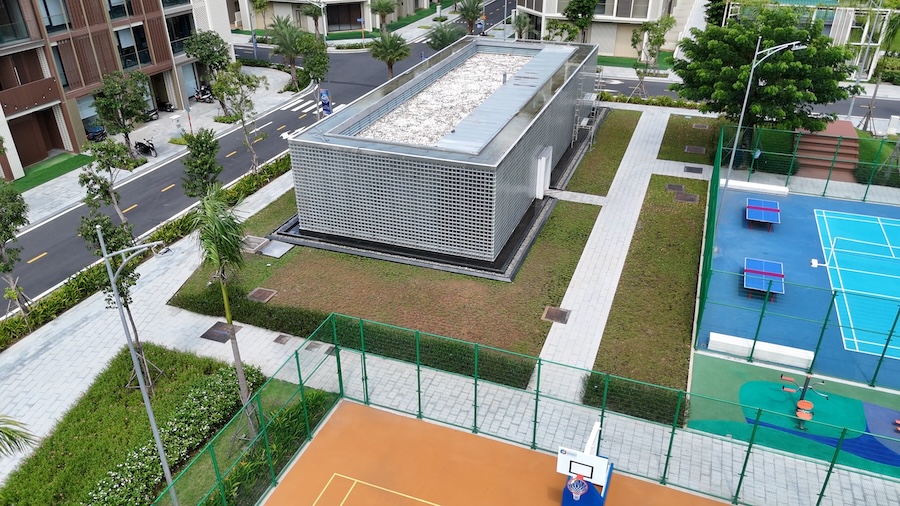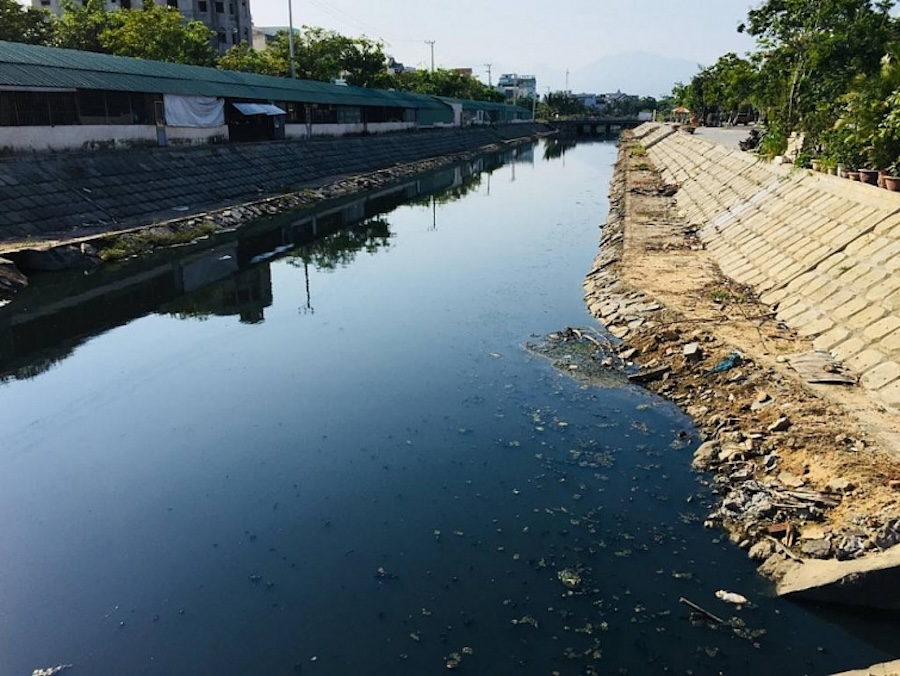Wastewater treatment in urban areas is becoming more urgent than ever before due to the rapid development of urban districts. The massive amount of wastewater from daily activities, commercial operations, and services, if not properly treated, will cause severe pollution to water sources, soil, and directly affect public health. Let's explore more details with Đại Nam in the article below.
1. Pollutants in Urban Wastewater
-
Organic matter: From food waste and household waste, biodegradable but can cause significant pollution if not treated.
-
Nutrients: Nitrogen and phosphorus from fertilizers and household waste, leading to water eutrophication.
-
Suspended solids: Sand, dirt, and waste, causing water turbidity and clogging pipes.
-
Pathogenic microorganisms: Bacteria, viruses, and parasites from household waste, posing risks for gastrointestinal and skin diseases.
-
Hazardous chemicals: Pesticides, herbicides, industrial chemicals, and heavy metals, negatively impacting human health and wildlife.
Urban wastewater treatment is crucial for protecting the environment and public health
2. Consequences of Improper Urban Wastewater Treatment
Wastewater from urban areas contains numerous pollutants, from biodegradable organic matter to hazardous chemicals and disease-causing microorganisms. If not treated thoroughly, these pollutants will enter groundwater, rivers, lakes, and oceans, causing:
-
Water pollution: Untreated wastewater discharged directly into rivers and lakes contaminates the water, affecting drinking water sources and aquatic ecosystems.
-
Disease outbreaks: Bacteria in wastewater accumulate, increasing the risk of waterborne diseases like diarrhea, cholera, or skin infections.
-
Unpleasant odors: Organic waste decomposition produces toxic gases like H2S, polluting the air and affecting residents' quality of life.
-
Ecosystem destruction: Chemicals and heavy metals in wastewater kill plants and animals, disrupting the natural balance.
-
Increased future treatment costs: To address severe pollution, authorities and residents will need to invest more resources to clean the environment.
-
Economic and social impacts: A deteriorating living environment decreases property values, tourism, and public health.
3. Detailed Urban Wastewater Treatment Process
3.1 Collection and Trash Separation Tank
-
Wastewater is filtered through a coarse mesh (5-10mm, SUS304) to remove large debris (10-20mm).
-
Prevents blockages in pumps and pipes.
-
Regular manual trash collection and disposal as per regulations.
-
Wastewater is pumped to the grease separator tank.
3.2 Grease Separator Tank
-
Wastewater is filtered through a fine mesh (3-5mm, SUS304) to remove small debris.
-
Protects pumps and systems from clogging.
-
Manual trash collection and proper disposal.
-
Gravity-based oil separation (3 compartments), with floating oils being removed. Water then flows to the balancing tank.
-
Meets QCVN 14:2008/BTNMT, Column A standards.
3.3 Balancing Tank
-
Stabilizes flow rate and pollutant concentration with a long retention time.
-
Stores wastewater during peak times for even distribution.
-
Controls high-pollution wastewater flow to prevent overloads.
-
Stores wastewater during system maintenance.
-
Prepares solid waste for further treatment.
3.4 Anoxic Tank
-
Nitrate and nitrite reduction, releasing N₂ gas.
-
Combines wastewater with high nitrate from the biological tank and sludge from the settling tank.
-
Adds alkaline chemicals and nutrients to adjust pH and support microbial growth.
-
Submersible mixers enhance treatment efficiency.
-
Water flows naturally to the aerobic MBBR tank.
3.5 MBBR Tank
-
Biological treatment using aerobic sludge on suspended media.
-
Large media surface area maintains high biomass, saving space.
-
Three-layer microbial membranes (anaerobic, anoxic, aerobic) effectively treat N, P, and BOD.
-
Aeration and oxygen distribution discs help decompose pollutants.
3.6 Aerotank
-
Reduces organic material using self-nourishing aerobic microorganisms.
-
Nitrate formation produces NO₃⁻ for the Anoxic tank.
-
Aerators provide oxygen, breaking down organic material into CO₂ and H₂O.
-
Floating sludge is recycled to the Anoxic tank, and the NO₃⁻-rich water circulates to reduce nitrogen.
3.7 Biological Settling Tank
-
Gravity-based separation of microbial sludge: clean water flows above, sludge settles below.
-
Water flows through overflow weirs into the disinfection tank.
-
Sludge is collected centrally, with part recirculated to the Anoxic tank, the rest sent to the sludge storage tank.
3.8 Disinfection Tank
-
Sodium hypochlorite (Javen) is added to eliminate pathogens.
-
The process involves Javen diffusing through cell walls and disrupting metabolic enzymes.
-
Water meets the standards before flowing into the monitoring canal.
3.9 Monitoring Canal
-
Assesses wastewater compliance with QCVN 14:2008/BTNMT, Column A standards.
-
Automatic monitoring station (pH, COD, TSS, flow rate) transmits data to the Ministry of Natural Resources and Environment.
-
Equipped with cameras and automatic sampling for continuous monitoring.
-
Water meeting the standards is then connected to the general drainage system.
3.10 Sludge Treatment
-
Prevents environmental pollution, odors, and adverse impacts on ecosystems and health.
-
Efficient sludge management ensures the sustainability of the wastewater treatment system.
-
The wastewater treatment process at Đại Nam applies advanced technology and modern equipment.
The urban wastewater treatment process at Đại Nam applies advanced technology and modern equipment
4. Advantages of Building a Wastewater Treatment System at Đại Nam
-
Optimized design tailored to specific treatment needs: Each wastewater treatment system at Đại Nam is designed based on input water characteristics, treatment requirements, and the customer's scale of operation for maximum efficiency.
-
Underground design: Wastewater treatment systems are implemented underground to save space. Developers can utilize the surface area for public amenities like parks, parking lots, sports facilities, or green spaces, enhancing urban aesthetics.
-
Application of advanced technology for high treatment efficiency: Đại Nam continuously updates and applies modern technologies like MBBR, MBR, and AAO to completely eliminate pollutants and meet strict environmental standards.
-
Cost savings on operation and long-term maintenance: The systems are designed to optimize energy consumption, chemical use, and workforce, reducing operational costs. Durable materials and high-quality equipment minimize repair costs.
-
Compliant with legal environmental standards: Đại Nam's wastewater treatment plants always meet Vietnam's environmental standards (QCVN), helping customers avoid legal risks and protect the environment.
-
Professional construction process: Đại Nam’s technical team follows strict procedures, using modern equipment, ensuring safety, and committing to timely project completion.
-
Experienced engineers and dedicated consultation: Đại Nam offers both technical solutions and operational advice with their team of engineers, supporting clients throughout the usage period.
-
Stable operation and easy control: Đại Nam’s systems are equipped with monitoring and measurement devices, ensuring continuous and accurate water quality control, minimizing operational failures.
-
Post-installation support and system upgrades: Đại Nam guarantees ongoing support after system commissioning, providing regular maintenance services and upgrading technologies when needed to keep the system running efficiently.

The system at Đại Nam is designed and built underground, saving space
Choosing the right urban wastewater treatment solution is key to achieving optimal results and ensuring compliance with environmental regulations. Contact Đại Nam today for comprehensive, sustainable wastewater treatment solutions to contribute to the creation of a livable urban environment for all.


